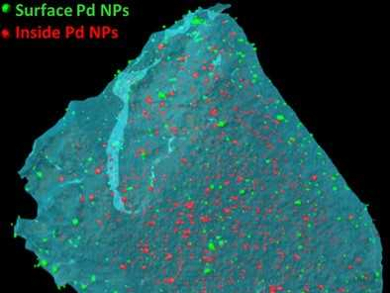Supported palladium nanoparticles can have excellent catalytic activity. Tailoring the 3D distribution of the nanoparticles on or in a porous carbon support can be used to control the selectivity and to improve the stability of catalysts.
Di Wang, Karlsruhe Institute of Technology, Eggenstein-Leopoldshafen, Germany, Alberto Villa, University of Milan, Italy, and colleagues have systematically investigated three catalysts with different Pd nanoparticle distributions on the external surface and inside the pores of a mesoporous carbon support (example pictured).
The Pd nanoparticles were immobilized on/in an ordered mesoporous CMK‐3 carbon support using three synthetic methods: incipient wetness impregnation, wet impregnation, and the immobilization of poly(vinyl alcohol) (PVA)-stabilized nanoparticles. The resulting distributions of the nanoparticles in the prepared catalysts were distinctly different from each other.
The team used quantitative electron tomography to determine the catalysts’ structure. They then studied the catalysts’ activity and selectivity in a furfural hydrogenation. The researchers found that more Pd nanoparticles located inside pores promote the formation of 2-methyl furan, while Pd particles on the external surface result in a higher yield of furfuryl alcohol and tetrahydrofurfuryl alcohol.
- Tailoring the 3D Structure of Pd Nanocatalysts Supported on Mesoporous Carbon for Furfural Hydrogenation,
Wu Wang, Alberto Villa, Christian Kübel, Horst Hahn, Di Wang,
ChemNanoMat 2018.
https://doi.org/10.1002/cnma.201800308




